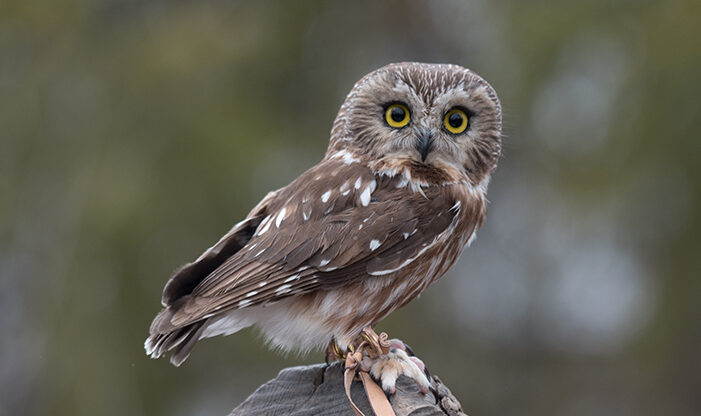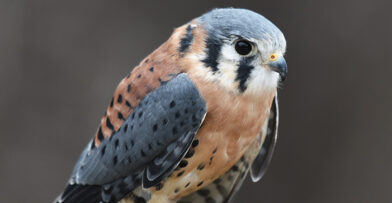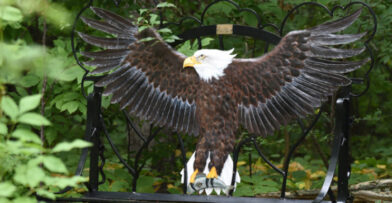Last December, our Raptor Program received an exciting message from the Wisconsin Humane Society Wildlife Rehabilitation Center: They had a Northern Saw-whet Owl that could not be released and hoped that we could provide her a forever home. We said yes! It has been five years since we said goodbye to our previous Saw-whet, Dory, and were honored to have the opportunity again to share this phenomenal species with the public.
Rescuing Our Northern Saw-whet Owl, Willow
Our new Northern Saw-whet Owl, Willow, is an adult female who was found on a sidewalk in Shorewood in October 2021 after experiencing a collision. Two residents, Genie and Tom, came across this little owl when they were on a dog walk. With the owl’s well-being in mind, they placed her in a nearby tree and asked neighbors to keep an eye on the area. Shortly after, they received a message that the owl was back on the sidewalk. While Genie watched over her, Tom went to get a box so that they could safely transport her to the WHS Rehabilitation Center in Milwaukee.
The medical team there discovered that Willow suffered a severe wing injury. Although they tried to fix the wing, due to the severity of her injury, she had lost full ability to fly. She was deemed non-releasable, and they reached out to us to see if Willow could join our program as a raptor ambassador.
Characteristics of Northern Saw-whet Owls
Ecologists have recently started to learn more about Saw-whet Owls in the wild. Research has found that the owls are partial migrants. While some individuals stay in place year-round, many move to lower latitudes for the winter. Southern Wisconsin is a popular overwintering region for many northern populations. Migrating Northern Saw-whet Owls are even known to cross the Great Lakes and other large bodies of water.
The Northern Saw-whet Owl is Wisconsin’s smallest owl species. The average female Saw-whet weighs in at just 3.5 ounces and has a 16-19 inch wingspan, actually making her the larger of the two sexes. Though it lives an incredibly secretive lifestyle, this tiny raptor is common and widespread across North America, preferring dense woodland such as conifer or mixed forest.
Like many small owls, the Northern Saw-whet Owl is a cavity nester and depends highly on dead trees for survival. It will also frequently use nest boxes.
Saw-whets hunt almost entirely at night, mostly by waiting on low perches and then swooping down on prey such as deer mice and other rodents, small birds, and insects. Its prominent facial disc and unique asymmetrical ear structure allow it to locate prey with great accuracy.
In some owl species, newly molted feathers fluoresce bright pink under ultraviolet light, making determining the age of the bird a far easier task. Using this technique when Willow joined us, our raptor staff was able to determine that Willow hatched in 2020. In the wild, Saw-whets can live as long as 7 years. In the care of humans, our birds do not face depredation, habitat competition, or lack of resources, so this species can live as long as 13-15 years with us.
Rehabilitating Willow and Other Wildlife
Southeastern Wisconsin has a strong network of wildlife organizations that we are honored to be a part of. It is our goal to spread awareness of raptor ecology and conservation throughout the community. Passionate and caring residents of the community can help wildlife in many ways: in this case, bringing injured wildlife to a permitted rehabilitation center. Wildlife rehabilitators such as the team at WHS Wildlife Rehabilitation Center work tirelessly to heal and release animals back to a life in the wild. In the unfortunate cases when an animal has sustained injuries too severe to be released, places like our Center can provide a forever home to wildlife while giving them the highest quality of care possible.
Northern Saw-whet Owls are one of the most charismatic species in wildlife conservation education. We are so grateful to Genie & Tom for finding her, for the partnership with the WHS Wildlife Rehabilitation Center that entrusted Willow with us, and excited for the new educational opportunities that she brings to our Raptor Program.


